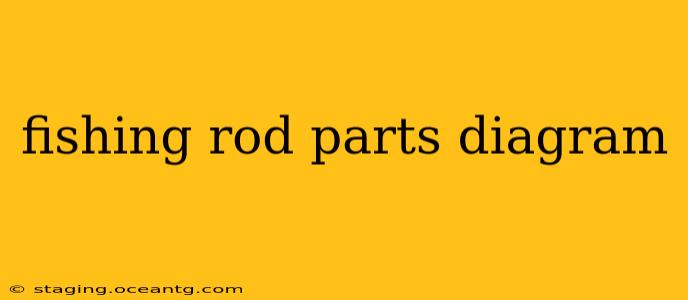Choosing the right fishing rod can feel overwhelming, especially when you're unfamiliar with its various components. Understanding the parts of a fishing rod is crucial for selecting the right tool for the job, maintaining it properly, and ultimately, enjoying a successful fishing experience. This comprehensive guide will break down each part of a fishing rod, complete with clear explanations and visual aids (although I can't provide actual images here). Think of this as your ultimate fishing rod anatomy lesson!
What are the Main Parts of a Fishing Rod?
A fishing rod, regardless of its type (spinning, baitcasting, fly fishing), generally comprises these key components:
- Tip: This is the very end of the rod, the most flexible part, and the first to bend when a fish takes the bait. Its sensitivity is crucial for detecting subtle bites.
- Tip-Top (or Tip Guide): Located at the very tip, it guides the fishing line smoothly as it is cast and retrieved. Different types of tip-tops exist, often made of ceramic or hard metal alloys.
- Guides (or Line Guides): These rings along the rod's blank direct the fishing line, reducing friction and ensuring smooth casting. Their size and spacing are designed for specific line types and weights.
- Rod Blank: This is the main body of the rod, usually made from graphite, fiberglass, or a composite material. The blank determines the rod's action, power, and overall performance.
- Butt Section (or Handle): This is the part you grip, usually made of cork, EVA foam, or other comfortable materials. The butt section provides a comfortable and secure grip during casting and fighting fish.
- Reel Seat: This is the part that holds the fishing reel securely to the rod. Different reel seats accommodate various reel types and sizes.
What are the Different Types of Fishing Rod Actions?
Understanding rod action is vital. It describes how much and where the rod bends under load:
- Fast Action: Bends primarily in the top third of the rod. Provides excellent accuracy and power for longer casts.
- Moderate Action: Bends in the middle third of the rod. Offers a good balance of power and sensitivity.
- Slow Action: Bends significantly along most of the rod's length. Ideal for finesse fishing and playing larger fish.
How Do I Choose the Right Fishing Rod for My Needs?
Selecting the appropriate rod depends on several factors:
- Type of Fishing: Different fishing styles (bass fishing, trout fishing, saltwater fishing) demand specific rod characteristics.
- Target Species: The size and fighting strength of the fish will dictate the rod's power and action.
- Line Weight: The rod's line weight rating indicates the appropriate line strength to use.
- Lure Weight: Similar to line weight, this specifies the weight of lures the rod is designed to cast effectively.
What Materials are Fishing Rods Made From?
Fishing rods are typically constructed from:
- Graphite (Carbon Fiber): Lightweight, strong, and sensitive, making it a popular choice for many rods.
- Fiberglass: More durable and forgiving than graphite, often preferred by beginners or for specific fishing techniques.
- Composite Materials: Blends of graphite and fiberglass, combining the strengths of both materials.
What is the Importance of the Reel Seat?
The reel seat's importance lies in its secure hold on the reel. A well-designed reel seat ensures the reel is firmly attached and doesn't slip during the fight with a fish. Different reel seat designs accommodate different reel foot sizes and styles.
How do I Maintain My Fishing Rod?
Proper maintenance will extend your rod's life:
- Clean it after each use: Wipe down the rod blank and guides to remove dirt and saltwater residue.
- Store it properly: Keep it in a rod case or protective sleeve to avoid damage.
- Inspect the guides: Check for damage or wear and tear. Replace guides if necessary.
This detailed explanation of fishing rod parts, along with its accompanying information, should provide anglers of all levels with a much clearer understanding of this essential piece of fishing equipment. Remember to always choose a rod that suits your fishing style and target species for optimal performance!
